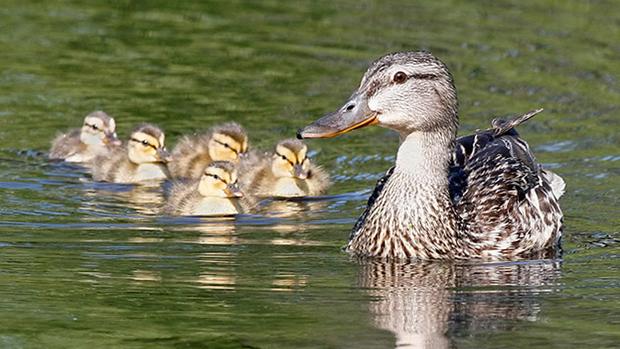Eastern Iowa Birding Calendar by Month
Scroll Down for More
by Tom Kent, Jim Fuller, and Jim Scheib; additions by Chris Caster and Chris Edwards

January
- Start new year’s bird list
- Rural winter roads get Horned Larks, Snow Buntings, Lapland Longspurs
- Bald Eagles near open water on rivers.
- Cedar Waxwings in fruit trees. Occasionally with a Bohemian Waxwing.
- Seven owls available this month: Great Horned, Long-earred, Short-earred, Screech, Saw-whet, Barred, and sometimes Snowy Owl.
- Northern Shrikes possible in open country.
- Red Crossbills or White-winged Crossbills possible in Hemlocks.
- Rare ducks possible in open water: Oldsquaw, scoters.
- Golden Eagles hunt in extreme NE Iowa thru February.
- Gray Partridge in open fields.
- Vagrant Gulls below dams.
February
- Finches should increase.
- Watch fruiting trees/shrubs for waxwings.
- Bald Eagles still at open water river sites.
- Bluebirds arriving by late February.
- Vagrant Gulls below dams.

March
- Northern Migrations start
- Look for: Bluebird, Robin, Cedar Waxwings, Grackles, Meadowlarks, Redwing Blackbird, Purple Finch, Song Sparrows, N. Harrier, Kestrel, Killdeer, Snipe, Mourning Dove, Flicker, Kingfisher, Eastern Phoebe, most ducks and several species of hawks.
- Northern migration of waterfowl: Canada and Snow Geese (white and blue phase) and Greater White-fronted Geese.
- Tundra Swans possible.
- Sandhill Cranes possible.
April
- American Woodcocks display in grassy areas near timber.
- New spring birds: Yellow Bellied Sapsucker (by the 10th), Chimney Swift, early Swallows, Martins, House Wren, Brown Thrasher, Kinglets, Hermit Thrush, Cowbird, Towhees, Gnatcatchers, Chipping Sparrow, Field Sparrow, Fox & White-Throated Sparrow, Savannah & Vesper Sparrow, first shore birds, early warblers: Yellow-rumped & Orange-crowned, Black & White, and Yellow-throated.
- Chickadees & Bluebird start nesting.
- Sora and Virginia rails in marshes late April.
- Ruffed Grouse drumming April/May.
- Yellow-headed Blackbirds singing on territory.
- Marshes have Sedge Wrens and Marsh Wrens, bitterns.
- Great Blue Herons, Great White Egrets arrive; occasionally a Sandhill Crane.
- Winter Wren in mid-month
- Smiths Lonsgspurs migration.
May
- Major songbird and shorebird migrations.
- Over 20 species of warblers. Most in first half of month. Five thrushes.
- Flycatchers, Cuckoos, Thrushes, and Vireos throughout the month.
- Peregrine Falcons follow shorebird migration.
- All swallows thru August: American Tree, N. Rough-winged, Bank, Barn, Cliff, Purple Martin
- Shorebirds seen on beaches and mud flats.
- Local birds nesting.
- Spring bird count

June
- Most birds nesting.
- Catbirds & Brown Thrashers mimic many songs.
- House Wrens wake you up with their singing.
- Swallow-tailed Kites have been seen over IC (rare but possible)
- Survey IBAs for breeding birds of conservation concern.
- Good time to look for grassland breeders: Bobolinks, Henslow’s Sparrows, Grasshopper Sparrows, Upland Sandpipers.
- Yellow-breasted Chat and Prothonotary Warblers head south by end of month
July
- Waxwings and Goldfinches finally nest as thistles, milkweed bloom.
- Summer dispersal of shore birds.
Some shorebirds migrate south at end of month.
Some birds start to moult by end of month.
Singing begins to die down as moulting birds hide in shrubs & weeds. - Young birds coming to feeders.
- Rare large water birds possible: Little Blue Heron, Snowy Egret.
- Non-breeding White Pelicans on reservoirs (through September).
August
- Goldfinch, Cedar Waxwings, Mourning Dove still nesting
- Blackbirds flocking.
- Migratory birds in full moult.
- Lots of baby birds at feeders.
- Ripening berries bring early migrants.
- Adult warblers finished breeding begin to trickle southwards.
- Early shore bird migration. Check mud flats for sandpipers, plovers.
- Buff-breasted Sandpipers possible.
- Shorebird flocks contain immature birds. Location tied to availability of mudflats.
- End of month: Orioles and Hummingbirds active at feeders
September
- First week: Orioles and Hummingbirds active at feeders
- Fall warbler migration. “Confusing fall warblers” have moulted to winter plumage.
- Rose-breasted Grosbeaks, Thrushes, Flycatchers, Cuckoos head south.
- Goldfinches in full moult.
- Quiet time for most songbirds.
- Shorebird migration nears completion.
- Accipiter and Broad-winged Hawk migration.
- Hawk migration peaks in latter half of September.
- Yellow-bellied Sapsucker late September, early October

October
- Local birds finishing their moult; Cardinals & Blue Jays normal again.
- Red-tailed Hawk migration
- Vagrant gulls begin to arrive.
- Sparrow and blackbirds primary songbird migrants.
- Summer bird migration is over; blackbirds last to go.
- Juncos will suddenly appear.
- Red-breasted nuthatch may have already arrived.
November
- Rare diving ducks on reservoirs before ice-up.
- Rough-legged Hawks arrive.
- Northern Shrikes possible.Anticipate Pine Siskins, Purple Finches, House Finches.
- More rare are: Evening Grosbeaks, Crossbills, Redpolls.
- Sign up for Annual Audubon Society Christmas Count.
December
- Cedar Waxwings like berry trees and a water source.
Saw-whet Owls winter in cedars. - Bald Eagles gather below dams after rivers freeze.
- Scout birding areas in preparation for Annual Bird Count.
